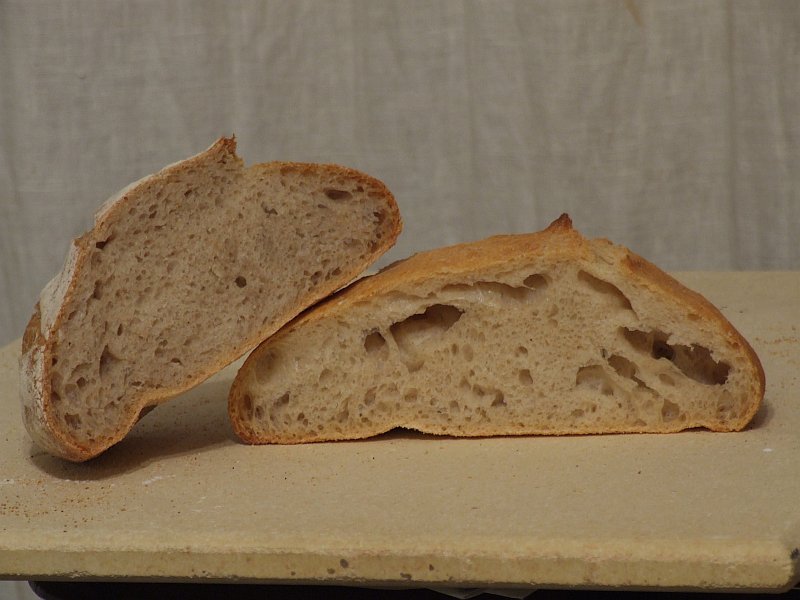I made two batches of bread in slightly different variations on the Pain de champagne from Reinhard's Bread Baker's Apprentice, and the results are quite different.

I'm working with the T55 Clone from NYBakers right now, and that's the bulk of the flour in both of these batches, with a little whole wheat added to one, and a little rye added to the other. The whole wheat is Anson Mills' Red Fife Bread Flour (Red Fife is an heirloom wheat, North America's preferred bread wheat in the 19th century), and the rye is Anson Mills' Abruzzi Rye Flour (another heirloom grain, from the colonial era, ground somewhat coarsely--they don't explicitly call it a whole rye, but I have the sense it might be, or approach it). In each case only about 7-8% of the flour that went into the recipe, so I'm not sure how significant the variety used really is.
Besides the whole wheat vs rye, the other difference was I added a little more water to the wheat batch. I started from a double batch of pate fermentee (100% T55), and the rest of the flour for each recipe in a soaker at room temperature. I would have liked the soakers to go 24 hours, but I probably used them after around 15 hours. I also proofed the wheat loaf on a peel (on top of the oven to raise it from fridge temp and proof it at the same time) and the rye loaf in a banneton (tipped so the load kind of nestled in the corner, since the banneton was too big for it) not on the oven so it would be behind the other loaf and ready when the wheat loaf was done baking.
When kneading the wheat batch I became concerned the dough was too firm. I like to push the hydration on this recipe, which opens up the crumb a bit. So I wet my hands a few times, and sprinkled little water on the dough as I kneaded. I didn't think I added very much, but the dough got quite slack, so perhaps I added more than I realized. This made me cautious about doing the same to the rye batch, and I decided to add no extra water to that at all, as it was already slightly stickier. This was all done on Friday.

Pictured are the second loaf from each batch which I baked today. (BTW, the color difference of the crumb is if anything more pronounced than in the photo, the rye noticably darker.) I baked the first loaf of each on Friday, and they had much the same in shape as these (the wheat much more flattened out), and like these, the crumb of the wheat was opener. But tonight's wheat loaf's crumb was WAY opener than Friday's. The crumb on Friday's wheat loaf was comparable to the opener crumbs I've gotten from this recipe without a levain, but I've never gotten anything like the huge irregular holes of today's loaf except the one time I added a levain to it.
Certainly the extra hydration explains the bigger crumb in the wheat loaf vs the rye. Perhaps the grain difference contributes too, though I'm not sure how much impact that 7-8% has. But the difference between Friday and today is surprising to me. I typically bake some of my loaves a day or two later with the dough resting in the refridgerator. It's never made much a difference before. One thing I did do differently this time, was I kneaded the dough a little bit after taking it out of the fridge, then shaped it. Could that have done it? Does anyone ever knead after a retardation between the first ferment and proofing?
- ericjs's Blog
- Log in or register to post comments